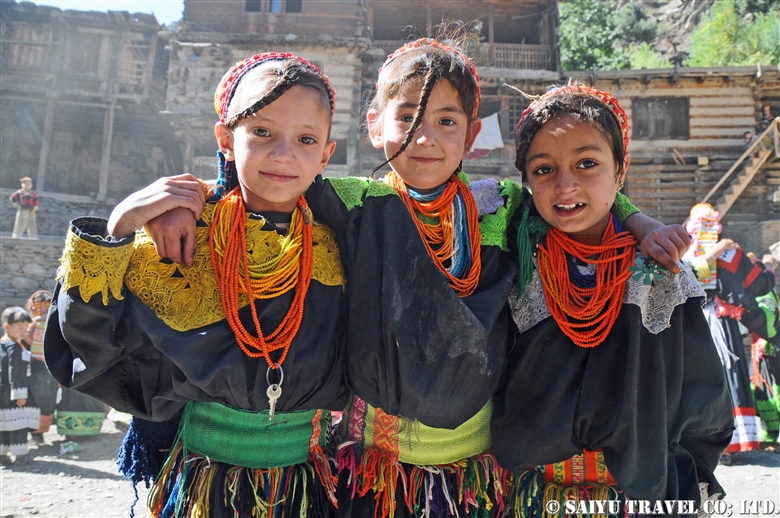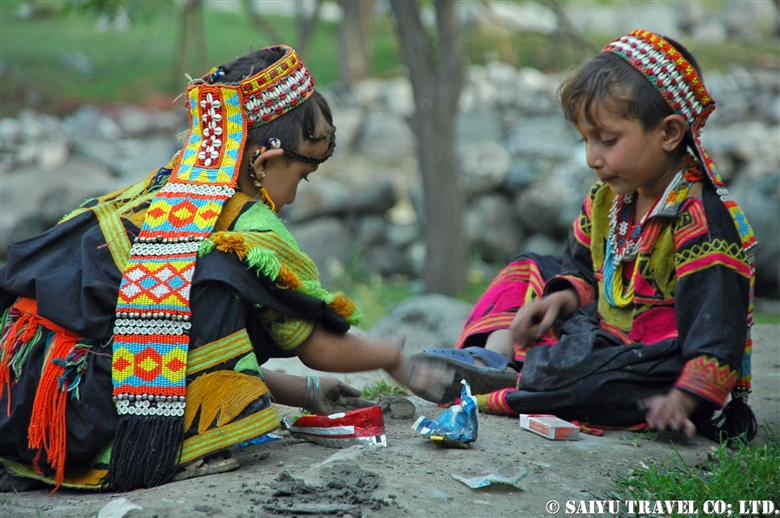
The Kalash’s religion is considered to be closer to Vedic and Pre-Zoroastrian cultures, even though it has a valuable existence that retains the old form of the Indo-Aryan religion. There is a God of Creator “Dezau” and many gods. There are gods closely related to life and nature, such as “Balumain”, “Sajigor” and “Mahan Deva” which appear at the Chaumos Festival and the goddess “Jestak” who protects the house. The place of prayer is called Dewa, and in each village has small altar at temple of Jestak han and the outskirts of the village.
Temple of Jestak han
Jestak is a goddess who controls the family, housework, marriage and each clan has a temple, not every village.There is a sheep motif at the entrance, Laternendeke ceiling which is typical in Pamir architecture decorations. There is a wood carving on the back of the temple that shows “Balumain” and there is mural painting from the Chaumos Festival.

There are two clans living in Karakal village in Bomboret Valley, and Jastak han has two entrances for each clan in one building.
The picture is Jastak han of Anish village. Designs and decorations inspired by goats and sheep. Laternendeke ceilings of typical architectural styles specific to mountains of Pakistan, Tajikistan and the Wakhan Corridor area.

The Gandao – Wooden statue
A wooden image created to admire the memories of dead person, contributions, and achievements. The production and rituals of this Gandao are very expensive and require a lot of goats, cheese and ghee. Thus, it can only be created by the rich men who are influential. In Bomboret Valley, two sons made two Gandao for their father and uncle, who died more than 10 years ago in Brun village in 2008. (It can still be seen in the Brun village cemetery).
The Gandao is at the center of the ceremonial place. People dance around it and after the ritual is completed, the Gandao is transported to the graveyard.

Cemetery Mandawjaw
The original burial of Kalash was to only put body in a wooden coffin and place in a cemetery. But about 50 years ago, they started practicing burial like Muslims. At present, things that seem to be whitening are old things about 50 years ago. In the past, it was said that if not covering the coffin, it was easy for the soul to free and naturally weatherable.

“Pure” and “Impure” concept
The Kalasha has the strong concept for “Pure” and “Impure” in their life. Therefore, there are many rituals to purify the things that they believe are impure.
The representative one is Bashari. It is a hut where women during menstruation gather and live together. Delivery is also carried out here, and after the delivery it is possible to return to the house where the husband is eagerly waiting after the purification ceremony. There is one in each village, and women in Bashari who are under menstruation should not touch others. For example, to pass the things to other person, She can throw it but cannot hand it over.

In short, it’s not easy to understand just by talking. You must visit here and see it for yourself !
Photo & Text : Mariko SAWADA
※ The photo was taken during the visit between 2006 and 2014.
Tag : Bomboret , Indus Caravan , Kalash people , Kalash valley , Saiyu Travel Pakistan , Kalasha , Bumburet Village , Khyber Pakhtunkhwa , Pakistan Travel company , Pakistan Blog , Pakistan tour operator , Pakistan Travel Blog , Pakistan Photography Tour , Rumbur , Rambur valley , Travel Pakistan Blog , Bumburet , Traveling Pakistan , Rambur village , Birir











